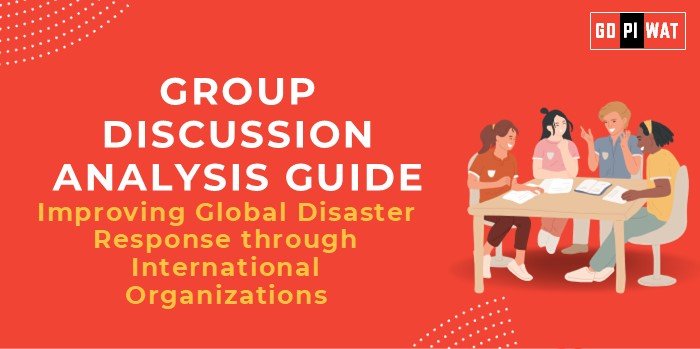📋 Group Discussion (GD) Analysis Guide
🌟 Improving Global Disaster Response through International Organizations
🌐 Introduction to the Topic
Context: Disasters affect millions worldwide annually, causing loss of life and extensive economic damage. The increasing frequency of climate-related and humanitarian crises demands robust, coordinated responses.
Background: International organizations like the UN, World Bank, and Red Cross play pivotal roles in disaster preparedness, response, and recovery. The Sendai Framework (2015-2030) provides a global blueprint for reducing disaster risk.
📊 Quick Facts and Key Statistics
- 🌍 Global Economic Losses: $313 billion annually due to natural disasters (UNDRR, 2022).
- 🌡️ Climate-Driven Disasters: Account for 70% of all natural disasters since 2000 (IPCC Report, 2022).
- 🧑🤝🧑 Humanitarian Needs: Over 330 million people required assistance in 2023 (UNOCHA).
- 💸 Funding Gap: Humanitarian funding shortfall exceeded $20 billion in 2023 (Global Humanitarian Overview).
👥 Stakeholders and Their Roles
- 🇺🇳 United Nations: Framework creation (e.g., Sendai Framework), coordination via OCHA.
- 🤝 NGOs: Provide grassroots support and field-level implementation (e.g., Red Cross).
- 🌍 Governments: Mobilize resources and facilitate international cooperation.
- 🏢 Private Sector: Develop innovative solutions and provide logistics.
- 📚 Academia: Research and data analysis for informed decision-making.
🏆 Achievements and Challenges
- 🎯 Achievements:
- Faster Response Times: Deployment of UNDAC teams within 24 hours.
- Increased Cooperation: Formation of partnerships like the Emergency Telecommunications Cluster.
- Technology Integration: Use of AI for disaster prediction by agencies like WMO.
- ⚠️ Challenges:
- Inefficient Coordination: Duplication of efforts among agencies.
- Funding Constraints: Chronic underfunding limits timely interventions.
- Infrastructure Gaps: Insufficient local capacity in vulnerable regions.
🌍 Global Comparisons
- 🇯🇵 Success: Japan’s disaster preparedness model (e.g., Tokyo’s earthquake drills).
- 🇭🇹 Challenge: Haiti earthquake response (2010) highlighted coordination flaws.
Case Study: Cyclone Amphan (India and Bangladesh, 2020) – Collaborative early warning systems saved thousands.
📋 Structured Arguments for Discussion
- ✔️ Supporting Stance: “International organizations have revolutionized global disaster response through initiatives like the Sendai Framework, saving lives and mitigating damage.”
- ❌ Opposing Stance: “Despite their mandates, international organizations often face challenges like resource limitations and bureaucratic inefficiency, delaying crucial aid.”
- ⚖️ Balanced Perspective: “While international organizations provide essential support, greater emphasis on funding and local capacity-building is needed for comprehensive disaster management.”
🛠️ Effective Discussion Approaches
- 🔍 Opening Approaches:
- Start with global statistics on disaster impacts.
- Highlight a successful collaboration like the response to Cyclone Amphan.
- 💬 Counter-Argument Handling:
- Acknowledge inefficiencies and propose solutions, such as streamlined coordination mechanisms.
📈 Strategic Analysis (SWOT)
- 🟢 Strengths: Global expertise, resource mobilization.
- 🟡 Weaknesses: Dependence on donor funding, slow bureaucratic processes.
- 🔵 Opportunities: Leverage technology, enhance local partnerships.
- 🔴 Threats: Increasing disaster frequency, geopolitical conflicts.
📚 Connecting with B-School Applications
- 🌏 Real-World Applications:
- Explore case studies on risk management and operations in disasters.
- 🤔 Sample Questions:
- “How can private-sector partnerships strengthen global disaster response?”
- “Discuss the role of technology in modernizing disaster management frameworks.”
- 💡 Insights for Students:
- Disaster management offers learnings in crisis leadership, logistics, and public-private collaboration.


